Related Research Articles

Hornblende is a complex inosilicate series of minerals. It is not a recognized mineral in its own right, but the name is used as a general or field term, to refer to a dark amphibole. Hornblende minerals are common in igneous and metamorphic rocks.
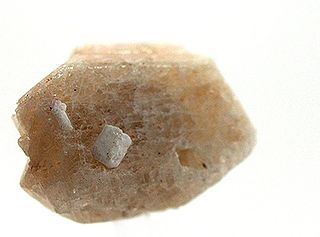
The mineral anorthoclase ((Na,K)AlSi3O8) is a crystalline solid solution in the alkali feldspar series, in which the sodium-aluminium silicate member exists in larger proportion. It typically consists of between 10 and 36 percent of KAlSi3O8 and between 64 and 90 percent of NaAlSi3O8.

Periclase is a magnesium mineral that occurs naturally in contact metamorphic rocks and is a major component of most basic refractory bricks. It is a cubic form of magnesium oxide (MgO). In nature it usually forms a solid solution with wüstite (FeO) and is then referred to as ferropericlase or magnesiowüstite.
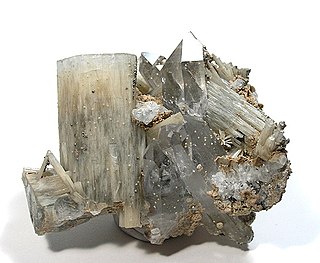
Zinnwaldite, KLiFeAl(AlSi3)O10(OH,F)2, potassium lithium iron aluminium silicate hydroxide fluoride is a silicate mineral in the mica group. The IMA status is as a series between siderophyllite (KFe2Al(Al2Si2)O10(F,OH)2) and polylithionite (KLi2AlSi4O10(F,OH)2) and not considered a valid mineral species.

Chabazite is a tectosilicate mineral of the zeolite group, closely related to gmelinite, with the chemical formula (Ca,K
2,Na
2,Mg)Al
2Si
4O
12•6H
2O. Recognized varieties include Chabazite-Ca, Chabazite-K, Chabazite-Na, and Chabazite-Sr, depending on the prominence of the indicated cation.
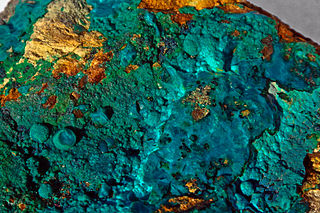
Silicate minerals are rock-forming minerals made up of silicate groups. They are the largest and most important class of minerals and make up approximately 90 percent of Earth's crust.

Harmotome is a mineral, one of the rarer zeolites; a hydrated barium silicate with formula: (Ba0.5,Ca0.5,Na,K)5Al5,Si11O32·12(H2O). It forms vitreous white well defined monoclinic crystals, often associated with calcite and other zeolites. It has a Mohs hardness of 4 to 5 and a specific gravity of 2.44 to 2.5.
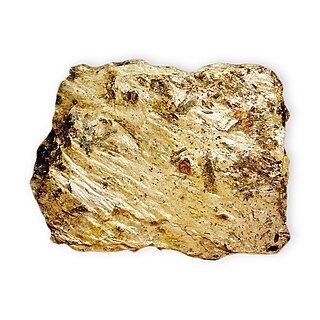
Paragonite is a mineral, related to muscovite. Its empirical formula is NaAl2(AlSi3O10)(OH)2. A wide solvus separates muscovite from paragonite, such that there is little solid solution along the vector Na+K+ and apparent micas of intermediate composition is most commonly a microscopic (or even sub-microscopic) intergrowth of two distinct micas, one rich in K, and the other in Na. Paragonite is a common mineral in rocks metamorphosed under blueschist facies conditions along with other sodic minerals such as albite, jadeite and glaucophane. During the transition from blueschist to greenschist facies, paragonite and glaucophane are transformed into chlorite and albite. Jadeite bearing pyroxene minerals have suggested Clinozoisite and paragonite are associated and derived from lawsonite releasing Quartz and water via the following reaction:

Afghanite, (Na,K)22Ca10[Si24Al24O96](SO4)6Cl6, is a hydrous sodium, calcium, potassium, sulfate, chloride, carbonate alumino-silicate mineral. Afghanite is a feldspathoid of the cancrinite group and typically occurs with sodalite group minerals. It forms blue to colorless, typically massive crystals in the trigonal crystal system. The lowering of the symmetry from typical (for cancrinite group) hexagonal one is due to ordering of Si and Al. It has a Mohs hardness of 5.5 to 6 and a specific gravity of 2.55 to 2.65. It has refractive index values of nω=1.523 and nε=1.529. It has one direction of perfect cleavage and exhibits conchoidal fracture. It fluoresces a bright orange.

Cerite is a complex silicate mineral group containing cerium, formula (Ce,La,Ca)
9(Mg,Fe3+
)(SiO
4)
6(SiO
3OH)(OH)
3. The cerium and lanthanum content varies with the Ce rich species and the La rich species. Analysis of a sample from the Mountain Pass carbonatite gave 35.05% Ce
2O
3 and 30.04% La
2O
3.

Clinozoisite is a complex calcium aluminium sorosilicate mineral with formula: Ca2Al3(Si2O7)(SiO4)O(OH). It forms a continuous solid solution series with epidote by substitution of iron(III) in the aluminium (m3 site) and is also called aluminium epidote.

Chloritoid is a silicate mineral of metamorphic origin. It is an iron magnesium manganese alumino-silicate hydroxide with formula (Fe, Mg, Mn)
2Al
4Si
2O
10(OH)
4. It occurs as greenish grey to black platy micaceous crystals and foliated masses. Its Mohs hardness is 6.5, unusually high for a platy mineral, and it has a specific gravity of 3.52 to 3.57. It typically occurs in phyllites, schists and marbles.

Wiluite is a dark green, brownish, or black blocky silicate mineral with the chemical formula Ca19(Al,Mg,Fe,Ti)13(B,Al,[ ])5Si18O68(O,OH)10. It has a Mohs hardness of 6 and a specific gravity of 3.36. It has a vitreous lustre, poor cleavage and an irregular brittle fracture. It crystallizes in the tetragonal system and occurs as well-formed crystals with good external form. It is isostructural with the vesuvianite group and is associated with wollastonite and olive-green grossulars (viluites) in a serpentinized skarn.

Osumilite is a very rare potassium-sodium-iron-magnesium-aluminium silicate mineral. Osumilite is part of the milarite group of cyclosilicates.
Akimotoite is a rare silicate mineral in the ilmenite group of minerals, with the chemical formula (Mg,Fe)SiO3. It is polymorphous with pyroxene and with bridgmanite, a natural silicate perovskite that is the most abundant mineral in Earth's silicate mantle. Akimotoite has a vitreous luster, is colorless, and has a white or colorless streak. It crystallizes in the trigonal crystal system in space group R3. It is the silicon analogue of geikielite (MgTiO3).
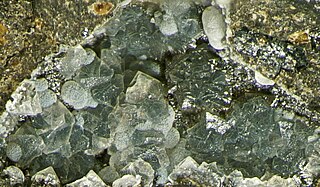
Faujasite is a mineral group in the zeolite family of silicate minerals. The group consists of faujasite-Na, faujasite-Mg and faujasite-Ca. They all share the same basic formula (Na2,Ca,Mg)3.5[Al7Si17O48]·32(H2O) by varying the amounts of sodium, magnesium and calcium. Faujasite occurs as a rare mineral in several locations worldwide.
Alsakharovite-Zn (IMA symbol: Ask-Zn) is an extremely rare alkaline strontium zinc titanium silicate mineral from the cyclosilicates class, with the chemical formula NaSrKZn(Ti,Nb)4(Si4O12)2(O,OH)4·7H2O, from alkaline pegmatites. It belongs to the labuntsovite group.
Bystrite is a silicate mineral with the formula (Na,K)7Ca(Si6Al6)O24S4.5•(H2O), and a member of the cancrinite mineral group. It is a hexagonal crystal, with a 3m point group. The mineral may have been named after the Malaya Bystraya deposits in Russia, where it was found.
Wiklundite is a rare and complex arsenite-silicate mineral with the chemical formula Pb2(Mn2+,Zn)3(Fe3+,Mn2+)2(Mn2+,Mg)19(As3+O3)2(Si,As5+O4)6(OH)18Cl6. The mineral characterizes in a large c unit cell parameter. It was found in Långban, Sweden - a home for many rare and exotic minerals.

Alpeite (IMA symbol: Apt) is a calcium manganese magnesium silicate mineral with the chemical formula Ca4Mn3+2Al2(Mn3+Mg)(SiO4)2(Si3O10)(V5+O4)(OH)6. It is named for its type locality, the Monte Alpe mine in Italy.
References
- ↑ Warr, L.N. (2021). "IMA-CNMNC approved mineral symbols". Mineralogical Magazine. 85 (3): 291–320. Bibcode:2021MinM...85..291W. doi: 10.1180/mgm.2021.43 . S2CID 235729616.
- ↑ http://www.mindat.org/min-25681.html Mindat
- ↑ Mihajlović T., Lengauer C.L., Ntaflos Th., Kolitsch U. and Tillmanns E. 2004: Two new minerals, Rondorfite, Ca8Mg[SiO4]4Cl2, and Almarudite, K([],Na)2(Mn,Fe,Mg)2(Be,Al)3[Si12O30], and a study of iron-rich Wadalite, Ca12[(Al8Si4Fe2)O32]Cl6, from the Bellerberg volcano, Eifel, Germany, Neues Jahrbuch für Mineralogie - Abhandlungen, 179, pp. 265-294;